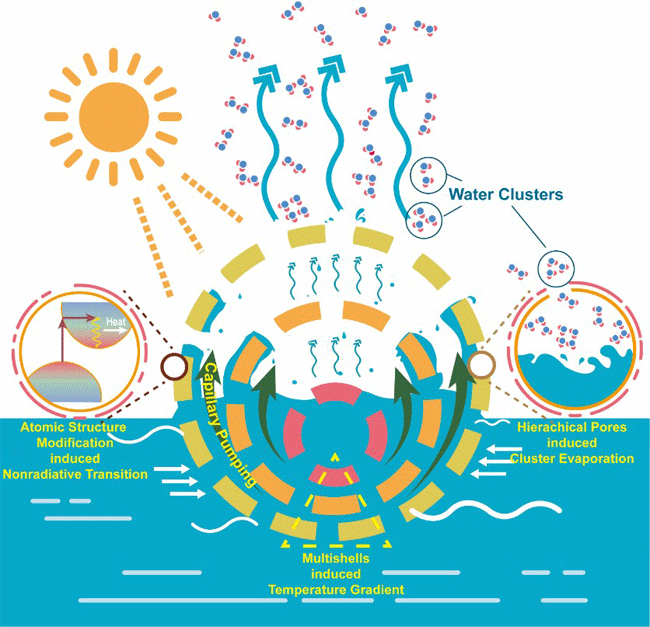[중국] 중국과학원, 정수효율 향상시키는 나노복합체 개발
공정공학연구소 왕단교수팀, 태양증발위한 HoMS의 초안정 무정형 ‘Ta2O5/C’ 개발
세계적인 식수 부족은 인간에게 심각한 문제이다. 정화는 많은 양의 화석에너지를 소비하고 2차 오염을 일으킨다.
태양열 계면 증발(Solar-thermal interfacial evaporation)은 이 문제를 해결하기 위한 가장 유망한 전략으로 여겨져 왔다. 하지만, 효율적인 태양 증발기 변환과 좋은 환경 내성을 특징으로 하는 최적화된 재료를 개발하는 것은 여전히 어려운 일이다.
중국과학원 공정공학연구소(IPE ; Researchers from the Institute of Process Engineering) 연구진이 태양 증발을 위한 중공 다층구조(HoMS ; hollow multishelled structure)의 초안정 무정형 ‘Ta2O5/C’ 나노복합체를 개발했는데, 이는 정수 효율을 향상시킬 수 있다.

이 연구의 저자인 왕단(Wang Dan) 교수는“HoMS(중공 다층 구조) 빌딩 블록의 정확한 원자 및 구성 제어는 페르미(Fermi) 레벨 주위에 풍부한 에너지 상태를 가진 간접적인 밴드갭(bandgap) 구조를 실현하고, 이것은 광열 변환을 용이하게 하기 위해 비방사성(nonradiative) 이완을 강화한다”라면서 “그 독특한 속이 빈 다층 구조물은 흑체(blackbody)처럼 빛의 흡수를 효율적으로 향상시킬 수 있다”라고 말했다.
HoMS(중공 다층 구조)는 물 증발에 필요한 에너지를 감소시킨다. 시뮬레이션 결과에 따르면 HoMS는 열장 구배(thermal field gradient)를 형성하여 증기 증발을 위한 원동력을 제공한다.
왕단(Wang Dan) 교수는 이어 “HoMS는 물 수송에도 도움이 된다”라면서 “HoMS의 밀폐된 구멍은 모세관 펌프 효과 때문에 액체 상태의 물 확산을 촉진하고, HoMS의 나노포어(nanopores)는 물분자가 군집의 형태로 증발하도록 유도하여 엔탈피(enthalpy)를 덜 가진 증발을 가능하게 한다”라고 강조했다.
IPE(중국과학원 공정공학연구소) 연구팀은 고효율 광흡수 및 광열 변환으로 4.02kg m-2h-1의 초고속 증발 속도를 달성했다. 증발 속도는 30일이 지나도 거의 변하지 않았고, 염분이 축적되지 않아 장기적인 안정성을 나타냈다. 특히, 가상 바이러스(pseudovirus) SC2-P의 농도는 증발 후 6차까지 감소할 수 있다.
이 무정형 ‘Ta2O5/C’ 복합체는 쉽게 제작, 운반, 보관 및 재활용된다. 그것은 바닷물의 정화 또는 중금속 또는 박테리아가 함유된 물에 적용되어 WHO(세계보건기구)의 기준에 맞는 음용수를 얻을 수 있다.
IPE(중국과학원 공정공학연구소)의 과학자들은 고립된 섬의 주민들을 위해 해수담수화 시제품을 준비하고 있다.
[원문보기]
New nanocomposite improves solar evaporation for water purification
Global drinking water scarcity is a severe problem for humans. Water purification consumes a large amount of fossil energy and generates secondary pollution.
Solar-thermal interfacial evaporation has been considered the most promising strategy for addressing this problem. However, developing an optimized material featuring both efficient solar-vapor conversion and good environmental tolerance still remains challenging.
Researchers from the Institute of Process Engineering (IPE) of the Chinese Academy of Sciences have developed an ultra-stable amorphous Ta2O5/C nanocomposite with a hollow multishelled structure (HoMS) for solar evaporation, which can improve the efficiency of water purification.
"The precise atomic and composition control in the building block of HoMS realizes an indirect bandgap structure with abundant energy states around the Fermi level, which enhances nonradiative relaxation to facilitate photothermal conversion," said Prof. Wang Dan, the corresponding author of the study, "The unique hollow multishelled structure can efficiently enhance light absorption like a blackbody."
HoMS decreases the energy required for water evaporation. Simulation results show that HoMS establishes a thermal field gradient, thus providing the driving force for vapor evaporation.
"HoMS also benefits water transport," said Wang, "The confined cavities in HoMS promote liquid water diffusion owing to the capillary pumping effect, and the nanopores in HoMS induce water molecules to evaporate in the form of clusters, thus enabling evaporation with less enthalpy."
With highly efficient photoabsorption and photothermal conversion, a super-fast evaporation speed of 4.02 kg m-2h-1 has been achieved. The evaporation speed barely changed after 30 days, and with no salt accumulation, indicating a long-term stability.
Notably, the concentration of pseudovirus SC2-P could be decreased by six orders of magnitude after evaporation.
This amorphous Ta2O5/C composite is readily fabricated, carried, stored, and recycled. It can be applied to the purification of seawater, or to heavy metal- or bacteria-containing water, obtaining drinkable water that meets the standard of the World Health Organization.
The scientists from IPE are preparing a prototype of seawater desalination for the residents on isolated islands.
[원문출처=중국과학원공정공학연구소(https://english.cas.cn/newsroom/research_news/chem/202111/t20211109_292033.shtml) / 2021년 11월 9일자 보도자료]

